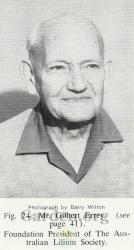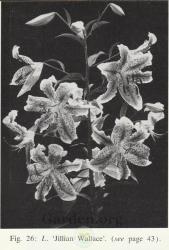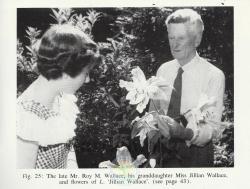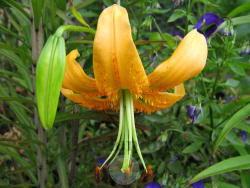Enjoyed the read.

If you couldn't find pollen, did you try 'Bellingham Star' as a pod parent this year, Lorn?
I hope I can add a bit of info here about the heritage of 'Tall Boy', as I looked some stuff up after Joe asked about it in the 2016 thread, and it's part of Australian lily history. There's a book called
Liliums in Australia by R. M. Withers, pub. 1967, and the information, pictures and quotes below come from that book.
Around 1913, the founding president of The Australian Lilium Society, Mr. Gilbert Errey, grew some 70 varieties of Lilium at Hazeldene, Victoria. Most of these lilies at the time were species and from his foundation stock Gilbert "...pioneered the hybridizing of liliums in Australia, at a time when hybrids were frowned upon as mongrels by lilium growers overseas." Time has proven one of his most important lilies to be a selection of
L. speciosum; 'Gilrey'. By the time of writing of
Liliums in Australia, 'Gilrey' was reported to be the source of all the dark colouring in Australian and New Zealand speciosum-auratum hybrids, that group we now call Orientals. 'Gilrey' had also became the pod parent of Australia's most famous lily, 'Jillian Wallace'.

Gilbert Errey.
"In 1919, Mr. Errey moved to Warbuton and in 1926 to Lilydale. Whilst living at Warbuton he met the late Mr. Roy Wallace, who later was to produce that famous lilium,
Lilium 'Jillian Wallace', one of the parents of which was
Lilium speciosum 'Gilrey', raised by Mr. Errey."
Still at Warbuton during the 1930s, Roy Wallace created
L. 'Jillian Wallace' and named it for his granddaughter, Jillian.
"It was during [the] period between the wars that
Lilium x parkmannii 'Jillian Wallace' was produced, and probably no other lilium is so widely known, or has achieved such acclamation throughout the world. Since the second world war, those gardeners in Australia who grow many or only a few liliums, have all grown it and marvelled at its grace, form and colour."

"In 1932, the late Mr. Wallace pollinated
L. speciosum 'Gilrey' with pollen from
L. auratum Crimson Queen. One seed capsule was produced and from it two seedlings were grown. In February, 1936, the two seedlings had reached flowering age. One flowered giving flowers just like a
L. speciosum. For no apparent reason the other bulb collapsed and rotted, but four small stem bulbs survived. These bulbs were planted out and flowered in February, 1939. Thus
L. 'Jillian Wallace' came into being and was named after Mr. Wallace's first grandchild who was born a few months earlier. In the years following,
L. 'Jillian Wallace' proved to be of exceptional vigour, showing that a bad start does not necessarily mean a bad future. On 11th September, 1951, a stem of
L. 'Jillian Wallace' was staged in London and received an award of merit from the Royal Horticultural Society."

It was to this famous lily, in 1971, that world-renowned Tasmanian breeder, Joe Hoell, applied pollen from
L. auratum var. platyphyllum and produced an auratum hybrid he named 'Valley Sundust'. The RHS description is as follows:
"Pinkish, with white tips and vivid reddish orange (32A) throat, outside pale yellow-green (157A); strong red (53B) spots in the throat; nectaries green; pollen vivid reddish orange (34A). Fls 160mm wide, slightly down-facing, slightly scented; petals 100 x 35mm, not ruffled, strongly recurved. Lvs alternate, 240 x 35mm, mid green. Stems 1.8m, green, streaked bronze, with 18-20 fls. January (Tasmania)."
I've never seen it myself and don't know if it is still grown anywhere, but would love to find it's still out there - if anyone knows!
Joe went further to use 'Valley Sundust' on
L. henryi and produced an outstanding inter-divisional he named 'Tall Boy'. That makes 'Tall Boy' is 1/2 henryi, 1/8 speciosum and 3/8 auratum.

Now, Joe shared 'Tall Boy' with other breeders, and the line continues into the future. (Though! I can think of several people that know the details far better than I, but it seems he also let a few siblings or similar lilies go out there when he didn't have enough of the genuine 'Tall Boy' - apparently he believed the shared genetics were the important thing so the rest of the family was as good as the star when it came to breeding! - and there may now be more than one "Tall Boy" in circulation.) Still, from Gilbert Errey to Roy Wallace to Joe Hoell, the genetics for 'Tall Boy' hold the dreams of pioneering Australian breeders and we're very fortunate to have this legacy to work with today.



